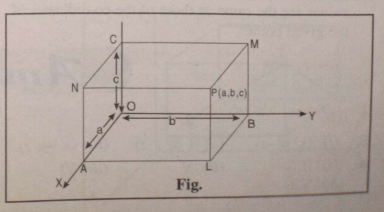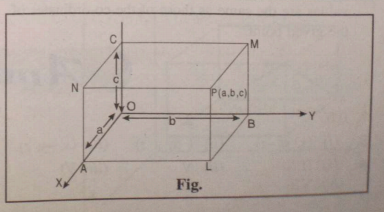Complete Solutions to EXAMPLE of chapter INTRODUCTION TO THREE DIMENSIONAL GEOMETRY of Class 11 book with complete answers and questions
| Class 11 | MATHS |
| Chapter | INTRODUCTION TO THREE DIMENSIONAL GEOMETRY |
| MODERN PUBLICATION | EXAMPLE |
| Number Of Questions | 30 |
| Academic Year | 2023-24 |
In the figure, if P is (a, b, c), find the co-ordinates of A, B, C and L, M, N.

View SolutionIn the figure, if P is (2, 4, 5), find the co-ordinates of N.

View SolutionIn the figure, find the co-ordinates of the reflection (image) of P in the XY-plane.

View SolutionName the octant in which the following points lie : (1, 2, 3).
View SolutionName the octant in which the following points lie : (4,-2,3).
View SolutionName the octant in which the following points lie : (4,-2,-5).
View SolutionName the octant in which the following points lie : (4, 2, - 5) .
View SolutionName the octant in which the following points lie : (- 4, 2, - 5).
View SolutionName the octant in which the following points lie : (-4, 2, 5).
View SolutionName the octant in which the following points lie : (- 3, -1, 6).
View SolutionName the octant in which the following points lie : (2, - 4, - 7).
View SolutionFind the distance between points : A(2,3,5) and B (4, 3, 1).
View SolutionFind the value of x, so that the point (6,5,-3) is at a distance of 13 units from the point (x,-7,0).
View SolutionFind the point on the Y-axis, which is equidistant from the points (3, 1, 2) and (5, 5, 2).
View SolutionUsing distance formula, show that the points A(-3, 2, 4), B(- 1, 5, 9) and C (1, 8, 14) are collinear.
View SolutionShow that the triangle with vertices (6, 10, 10), (1, 0, - 5) and (6, - 10, 0) is a right-angled triangle.
View SolutionShow that the points : A (0,1,2),B(2,-1,3) and C (1,-3,1) are vertices of an isosceles right angle triangle.
View SolutionShow that the points (5, - 1, 1),(7, - 4, 7), (1, - 6, 10) and (- 1, -3, 4) are the vertices of a rhombus.
View SolutionFind the co-ordinates of the point, which is equidistant from four points (0, 0, 0), (a, 0, 0), (0, b, 0) and (0, 0, c).
View SolutionFind the equation of the set of points P such that its distances from the points A (3, 4, - 5) and B (- 2, 1, 4) are equal.
View SolutionFind the co-ordinates of the point, which divides the line segment joining the points (5, 4, 2) and (-1, -2, 4) in the ratio : 2:3 .
View SolutionFind the co-ordinates of the point, which divides the line segment joining the points (5, 4, 2) and (-1, -2, 4) in the ratio : 2:3 .
View SolutionFind the co-ordinates of the point R, which divides [PQ] externally in the ratio 2: 1 and verify that Q is the mid-point of PR.
View SolutionA point R with x-co-ordinate 4 lies on the line segment joining the points P(2,-3,4) and Q(8,0,10). Find the co-ordinate of the point R.
View SolutionFind the ratio in which the plane `3x+ 4y-5z =1` divides the line joining the points (-2, 4, -6) and (3, - 5, 8).
View SolutionUsing section formula, prove that the three points (- 4, 6, 10), (2, 4, 6) and (14,0,-2) are collinear.
View SolutionA (3, 2, 0), B(5, 3, 2), C(- 9, 6, -3) are three points forming a triangle. AD, the bisector of `anlge BAC` meets [BC] at D. Find the co-ordinates of D.
View SolutionShow that the points (3, -1, -1), (5,-4, 0), (2, 3, -2) and ( 0, 6, -3) are the vertices of a parallelogram*.
View SolutionFind the third vertex of the triangle whose centroid is (7, -2, 5) and whose other two vertices are (2, 6,-4) and (4, -2, 3).
View SolutionProve that the lines joining the vertices of a tetrahedron to the centroids of the opposite faces are concurrent.
View Solution
EXAMPLE questions and complete solutions for chapter INTRODUCTION TO THREE DIMENSIONAL GEOMETRY of MODERN PUBLICATION of Class 11